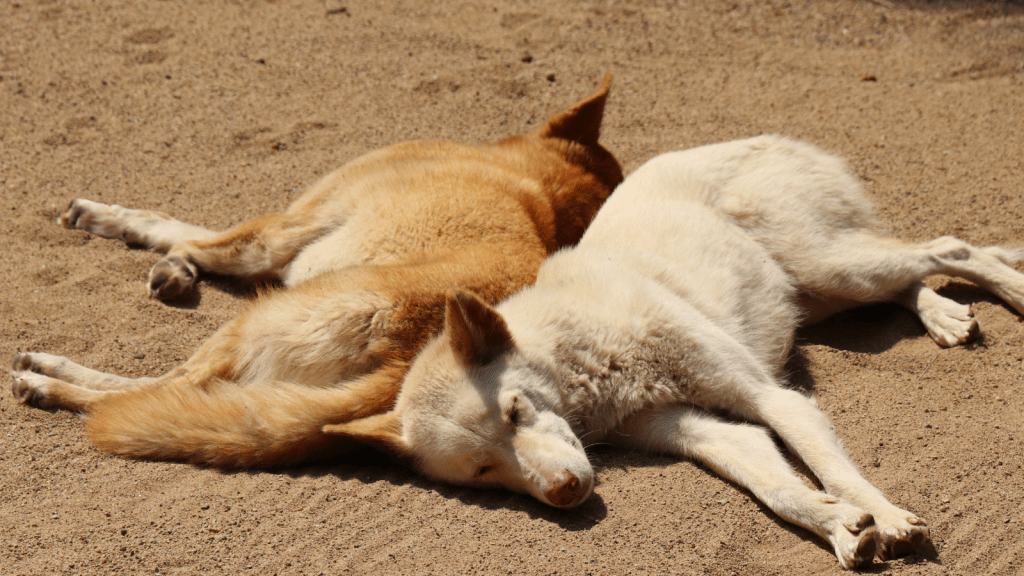
Dingoes may be Australia’s only native canine, but these unique animals have a negative reputation that puts their survival in jeopardy. They may not seem important, but from both a cultural and ecological perspective, dingoes deserve our respect and attention.
Let’s examine the truth behind the dingo to explore the hardships they experience, their past influence, and how we humans can help preserve their futures.
The State of Dingoes Today
Once widespread across Australia, the dingo population has declined dramatically in recent decades. Habitat loss, human-wildlife conflicts, and interbreeding with domestic dogs have contributed to their downfall, but they still play a crucial role in balancing ecosystems.
The conservation status of the dingo varies from state to state. Some local governments consider them pests, while others like Victoria classify them as a threatened species. Their decline usually outweighs their preservation, however, as Australia is known for having the highest rate of animal extinction in the entire world.
In fact, it’s difficult to track the status of the dingo population at all. The government has failed to track how many dingoes it has killed, let alone how many are left. The lack of consistency between humans and dingo relations only makes their protection more challenging to coordinate.

Agriculture’s Impact on Dingo Wellbeing
A major driver in dingoes’ destruction has been agriculture, and big agriculture in particular. Large-scale land clearing, fencing, and invasive species have disrupted their migratory patterns, while livestock owners’ fear for their animals has led to killing campaigns. Meat baits laced with poison are a common hunting method, as well as leghold traps.
These killings are often justified by the misconception that dingoes are hybrid “wild dogs” from interbreeding with domesticated dogs. This has led to governments permitting their killings to help eradicate the “pest species,” but science has proven this narrative false. In 2021, the University of South Wales found that 99% of caught “wild dogs” were pure-bred dingo or nearly pure-bred.
First Nations Peoples and Dingoes
But dingoes were not always treated this way. For thousands of years, dingoes held a significant place in the cultures and traditions of Aboriginal and Torres Strait Islander peoples. These communities have a deep respect for dingoes, often regarding them as spiritual beings and companions.
Dingoes even feature prominently in their art, storytelling, and ceremonies, reflecting the intrinsic connection between First Nations peoples and the natural world. This relationship was spotlighted in September 2023, when the first-ever First Nations dingo forum was held in Cairns. The gathering denoted dingoes as the “Boss of Country,” advocating for the end of all dingo killings across Australia.
Traditional knowledge of the dingo can be the solution to their future survival, if we’re willing to learn from these early norms.

Pumbah’s Visit to Parliament
In November 2023, a dingo named Pumbah visited Canberra to enter Parliament. His visit aimed to demonstrate to lawmakers that the species’ persecution has been based on misinformation and misconceptions.
Scientists, First Nations representatives, and dingo enthusiasts travelled from all around the continent to join the session in support of Pumbah. The symbolic event drew attention to the importance of preserving Australia’s unique biodiversity and animal relationships to policymakers and citizens alike.
 Cultivating Interspecies Peace with Dingoes
Cultivating Interspecies Peace with Dingoes
At the core of the human-dingo conflict is human-centric thinking, where we automatically place ourselves at the top of the pyramid. What would Australia look like if we viewed the ecosystem through the dingoes’ perspective?
Instead of treating flora and fauna as subservient to humans, we need to return to First Peoples practices where communication with dingoes once flourished. After all, interspecies peace is not only possible with dingoes, but was once standard cultural practice across Australia.
One of the most powerful tools we possess is our ability to communicate, but this does not always mean verbal methods. By understanding who dingoes truly are – misinformation aside – we can build a pathway for both humans and dingoes to live side by side in peace.
How You Can Help Dingoes
Want to develop your animal communication skills to better understand other species’ perspectives? My upcoming Australia Animal Communication Training in July 2024 will explore the ins and outs of the human-animal connection to help you fine-tune your relationship with the natural world.
For more information on animal communication and updates from the animal kingdom, visit the Animal Thoughts Blog.
Pea Horsley is an international teacher, TEDx speaker and bestselling author of 3 books including ‘Heart to Heart’ and ‘The Animal Communicator’s Guide’, which have been translated into nine languages, online course Animal Communication Made Easy, and creator of the Conversations with Nature World Summit. Pea is the UK’s most highly regarded animal communicator and wild animal retreat facilitator. Join Pea’s membership, The Pride, and be part of a global community listening to a council of animals advising humanity and together forging real transformation.

